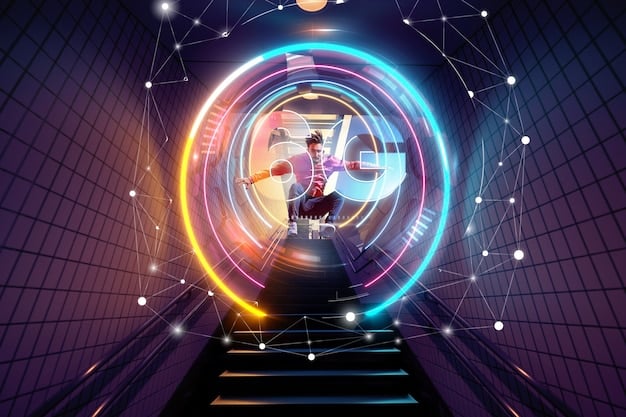The Impact of 5G on Esports: A US Technical Analysis

The Impact of 5G on Esports Gaming in the US: A Technical Analysis explores how 5G technology is transforming the esports landscape in the United States, enhancing gameplay, streaming quality, and overall fan experience through its superior speed and low latency.
The world of esports is rapidly evolving, and one of the key drivers of this evolution is the advent of 5G technology. This article, The Impact of 5G on Esports Gaming in the US: A Technical Analysis, delves into how 5G is poised to revolutionize esports gaming in the United States.
Understanding 5G Technology
5G, the fifth generation of wireless technology, is more than just an incremental upgrade; it’s a transformative leap in connectivity. It offers significantly faster speeds, lower latency, and greater bandwidth capacity compared to its predecessor, 4G. This technological advancement has profound implications across various industries, with esports being one of the most impacted.
Key Features of 5G
5G operates on higher frequency bands, including millimeter wave (mmWave), which enables faster data transmission. It also employs advanced technologies such as massive MIMO (Multiple-Input Multiple-Output) and beamforming to enhance network efficiency and capacity.
- Enhanced Mobile Broadband (eMBB): Delivers high data rates for bandwidth-intensive applications like streaming and gaming.
- Ultra-Reliable Low Latency Communications (URLLC): Provides extremely low latency, crucial for real-time applications such as remote surgery and esports.
- Massive Machine-Type Communications (mMTC): Supports a vast number of connected devices, enabling smart city applications and IoT deployments.
The combination of these features makes 5G a game-changer, enabling new possibilities and applications that were previously unattainable with older technologies. For esports, this means smoother gameplay, higher-quality streaming, and improved accessibility for players and fans alike.
In conclusion, 5G technology, with its enhanced speed and reliability, represents a monumental shift. Its impact on esports is poised to be transformative, enhancing both the gaming experience and the industry’s operational capabilities.
The Latency Factor in Esports
In competitive gaming, every millisecond counts. Latency, or the delay between an action and the corresponding reaction in the game, can be the difference between victory and defeat. High latency leads to lag, stutters, and unresponsive controls, severely impacting the player’s performance.
How 5G Reduces Latency
5G’s ultra-reliable low latency communications (URLLC) are designed to minimize these delays. By significantly reducing latency, 5G ensures that gamers experience near-real-time interactions, providing a level playing field and enhancing competitive integrity.
Reduced latency not only benefits professional players but also improves the overall gaming experience for casual players. Lower latency means smoother gameplay, more responsive controls, and a more immersive experience, regardless of the game being played.
- Improved Responsiveness: Actions are executed almost instantly, providing a seamless gaming experience.
- Enhanced Precision: Gamers can react more quickly and accurately, leading to better performance.
- Fair Competition: Lower latency ensures that all players have an equal opportunity to compete, regardless of their location or network conditions.
Ultimately, the impact of 5G on latency in esports cannot be overstated. By minimizing delays and ensuring near-real-time interactions, 5G is paving the way for a new era of competitive gaming, where skill and strategy are the primary determinants of success.

Enhanced Streaming Capabilities
Streaming has become an integral part of the esports ecosystem, allowing fans to watch live tournaments, analyze gameplay, and engage with their favorite players. However, high-quality streaming requires significant bandwidth and reliable network connectivity.
5G’s Role in High-Quality Streaming
5G’s enhanced mobile broadband (eMBB) capabilities provide the necessary bandwidth to support high-definition (HD) and even ultra-high-definition (UHD) streaming. With 5G, esports fans can enjoy crystal-clear video quality, smooth playback, and minimal buffering, enhancing their viewing experience.
5G not only improves the quality of live streams but also enables new interactive features. Viewers can participate in real-time polls, access multiple camera angles, and even interact with players during the game, creating a more immersive and engaging experience.
- Higher Resolution: Supports HD and UHD streaming for sharper and more detailed visuals.
- Lower Buffering: Minimizes interruptions and delays, providing a seamless viewing experience.
- Interactive Features: Enables real-time polls, multiple camera angles, and player interactions, enhancing viewer engagement.
In summary, 5G technology is transforming the streaming landscape in esports, providing fans with higher-quality video, smoother playback, and more interactive features. As streaming becomes an increasingly important aspect of esports, 5G will play a pivotal role in delivering exceptional viewing experiences.
Mobile Esports and 5G
Mobile esports, or competitive gaming on mobile devices, has experienced significant growth in recent years, fueled by the widespread availability of smartphones and the increasing popularity of mobile games. However, mobile esports faces unique challenges, including limited processing power and unreliable network connectivity.
5G’s Impact on Mobile Gaming
5G’s high speeds and low latency address these challenges, enabling mobile gamers to enjoy a lag-free and immersive experience. With 5G, mobile games can deliver console-quality graphics and gameplay, attracting a broader audience and driving further growth in the mobile esports sector.
5G also enables new possibilities for mobile esports tournaments and events. Mobile gamers can compete remotely with minimal latency, allowing for larger and more inclusive tournaments. The increased bandwidth also supports high-quality streaming, enabling fans to watch mobile esports events in HD and UHD.
The rise of cloud gaming further accelerates the accessibility and adoption of mobile esports. Cloud gaming allows processing-intensive games to run remotely and be streamed directly to the user’s device, bypassing the hardware limitations of mobile devices. With 5G’s superior speed and low latency, cloud gaming can function at higher quality for more users, further leveling the playing field and potentially leading to a surge in global and regional mobile gaming competitions. All segments of the population would have access to high-quality gaming, regardless of their hardware capabilities and locations.
Consider that while mobile games can generate sizable revenues, most competitive environments necessitate gaming PCs or consoles connected to a high-performance network and display. If 5G can truly offer low latency capabilities, then competitive play can occur on mobile devices running on 5G. Some analysts believe that competitive mobile gaming through cloud gaming could become even more disruptive in the future as the ecosystem matures and more cloud-based gaming platforms and services become available. With more developers now optimizing the 5G network across a wide gamut of use cases, the technology could further empower cloud-based mobile gaming.
- Lag-Free Experience: Provides low latency and high speeds for smooth gameplay.
- Console-Quality Graphics: Enables mobile games to deliver stunning visuals and immersive experiences.
- Remote Tournaments: Supports remote participation in mobile esports events, expanding accessibility and inclusivity.
In conclusion, 5G is a catalyst for the growth of mobile esports, addressing key challenges and enabling new possibilities. As mobile gaming continues to gain popularity, 5G will play a crucial role in delivering exceptional experiences and driving further growth in the sector.

Infrastructure and Deployment Challenges
While 5G offers numerous benefits for esports, its widespread adoption faces several infrastructure and deployment challenges. Building out the necessary infrastructure, including cell towers, base stations, and fiber optic cables, requires significant investment and time.
Addressing the Challenges
One of the key challenges is ensuring sufficient coverage, particularly in rural and underserved areas. 5G signals have a shorter range compared to 4G, requiring a denser network of cell towers to provide adequate coverage. Overcoming these challenges requires collaboration between telecommunications companies, government agencies, and local communities.
Another challenge is managing network congestion, particularly during peak hours. Esports events often draw large crowds, leading to increased demand for network resources. To address this, telecommunications companies can deploy network optimization techniques, such as dynamic spectrum sharing and network slicing, to prioritize esports traffic and ensure a consistent experience.
In addition, security must also be considered. Cybersecurity is one of the largest threats to the esports industry; the high level of engagement and visibility, combined with monetary rewards, makes them attractive targets for both individual hackers and sophisticated cybercriminal groups. Thus, providers must ensure that the necessary security mechanisms are in place to prevent intrusions or fraud. Network security and edge security are two ways to enhance protection, providing a robust security posture.
- Coverage: Expanding 5G coverage to rural and underserved areas.
- Capacity: Managing network congestion during peak hours.
- Security: Ensuring secure and reliable network connectivity.
In summary, addressing infrastructure and deployment challenges is crucial for realizing the full potential of 5G in esports. By overcoming these obstacles, telecommunications companies can pave the way for a new era of competitive gaming, characterized by faster speeds, lower latency, and more immersive experiences.
The Future of Esports with 5G
Looking ahead, the future of esports with 5G is bright. As 5G networks become more prevalent and affordable, we can expect to see even greater innovation and growth in the esports sector. 5G will enable new types of esports games, more immersive viewing experiences, and greater accessibility for players and fans alike.
Emerging Trends
One emerging trend is the integration of augmented reality (AR) and virtual reality (VR) into esports. AR and VR technologies offer new ways to experience and interact with esports content, creating more immersive and engaging experiences. 5G’s high bandwidth and low latency are essential for delivering these AR and VR experiences without lag or interruptions.
Another trend is the rise of cloud gaming, which allows gamers to stream games directly to their devices without the need for expensive hardware. 5G’s superior speed and low latency make cloud gaming a viable option for esports, enabling gamers to compete on high-end games without investing in expensive gaming PCs or consoles.
- AR/VR Integration: Creating more immersive and engaging esports experiences.
- Cloud Gaming: Enabling gamers to compete on high-end games without expensive hardware.
- New Game Genres: Paving the way for new types of esports games that leverage 5G’s capabilities.
In conclusion, 5G is poised to revolutionize the esports industry, enabling new possibilities and driving further growth. As 5G networks continue to expand and evolve, we can expect to see exciting new developments in esports, creating more immersive, accessible, and engaging experiences for players and fans around the world.
| Key Point | Brief Description |
|---|---|
| 🚀 Reduced Latency | 5G’s low latency ensures faster response times in esports gaming. |
| 📺 Enhanced Streaming | 5G enables high-quality, lag-free streaming for esports viewers. |
| 📱 Mobile Esports Growth | 5G supports higher-quality mobile gaming, enhancing esports accessibility. |
| 🌐 Infrastructure Development | 5G deployment requires significant infrastructure upgrades and expansion. |
[Frequently Asked Questions]
▼
5G improves esports gaming through reduced latency, enabling faster response times and smoother gameplay. This leads to more competitive and enjoyable experiences for players.
▼
5G enhances streaming by providing high-quality, lag-free video, ensuring viewers can enjoy esports events without interruptions. This also supports interactive features for better engagement.
▼
5G allows for higher-quality graphics and reduced lag on mobile devices, making mobile esports more accessible and competitive. This helps in expanding the mobile esports audience.
▼
5G deployment requires extensive infrastructure including cell towers and fiber optic cables, which ensures wide coverage and high capacity. This is vital for reliable esports connectivity.
▼
The future involves increased AR/VR integration, cloud gaming, and new game genres that require 5G’s capabilities. This leads to a more immersive, accessible, and engaging esports ecosystem.
Conclusion
In conclusion, the integration of 5G technology is set to revolutionize the esports industry, enhancing gameplay, streaming quality, and mobile gaming experiences. Addressing infrastructure challenges will unlock new possibilities, promising a more immersive and accessible future for players and fans alike.





